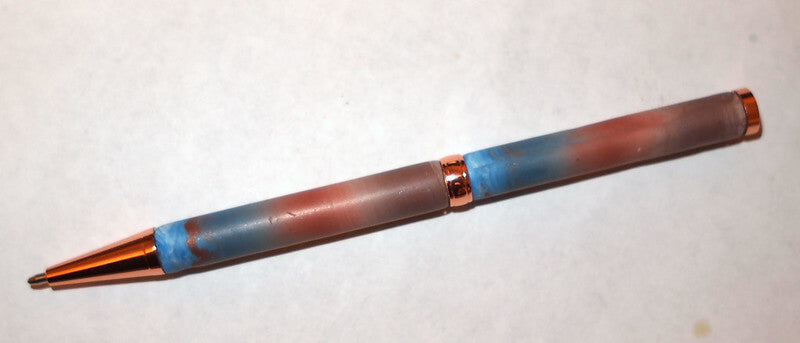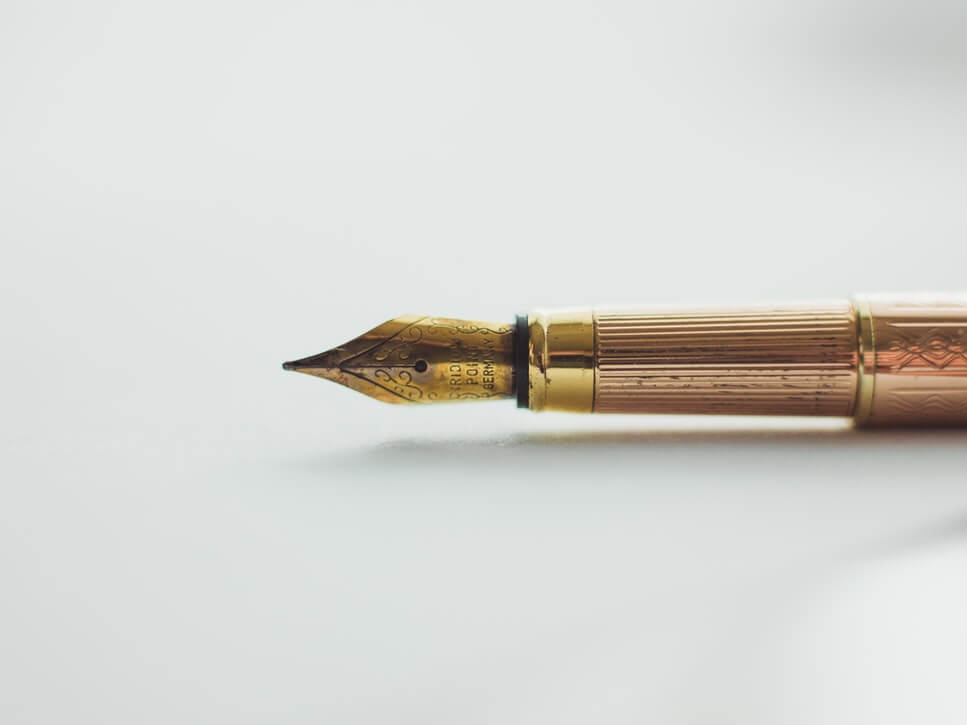In this post, we reveal everything you need to know about copper pens, including our recommendations on the best copper pens. Let's get started!
Introduction
Instead of always using disposable pens, why not invest in a writing instrument that will last a lifetime? A copper pen is built from timeless copper. The pens are durable and crafted for the long haul. The materials used to make copper pens age and provide a unique look that most people absolutely love.
In this article, we'll explore the history of copper pens, the advantages of copper, the aging of copper pens and patina, the various types of copper pens, and the difference between copper pens with a resin or lacquer coating and copper pens made without any resin or lacquer coating. In addition, we’ll outline the factors to consider when shopping for a copper pen and show you what to do to keep your copper pen looking new and shiny.
What is a Copper Pen?
A copper pen is a writing instrument that is made of metallic copper, which is a reddish-gold, soft, and extremely ductile metal. The metal is an excellent conductor of heat and electricity. In addition, copper pens have anti-microbial properties, which makes them useful for everyday use as well as in healthcare facilities and other sensitive places.
Years ago, researchers realized that frequently touched objects which are not promptly sanitized, like keyboards, doorknobs, cell phones, and pens, are often covered with harmful bacteria and viruses. Following numerous tests and evaluations, the U.S. Environmental Protection Agency registered copper alloys and items made from the alloys, such as pens, as anti-microbial public health materials. As a result, copper pens became increasingly popular.

Copper has been used for centuries for its anti-microbial qualities; in fact, studies have shown that the metal kills 99.9 percent of bacteria within two hours. This unique feature makes it an ideal material for surfaces in sensitive environments like hospitals and medical laboratories. As stated in an article published by the American Society of Microbiology Journal notes that viruses, bacteria, and yeasts are all killed when they are on metallic copper surfaces.”
There is something quite unique about copper that exceeds its physical features. Studies have shown that copper is one of only a handful of metals that exist in pure element form. Also, copper has an elegant appearance that becomes more beautiful with age. This is because copper interacts with its environment and naturally oxidizes over time, acquiring a beautiful patina.
Copper pens are distinct in that they have a faint metallic scent, which is comparable to the scent of a penny. This scent can be transferred to the user's hand for a short period. This scent is completely normal and harmless. The scent is the result of the formation of very small amounts of ketones when copper, as well as copper-based alloys, come into contact with human skin. In fact, the scent can be helpful in helping distinguish between real copper and fake, copper-looking materials. A copper pen can be easily cleaned with a soft cloth.
History of Copper Pens
The anti-bacterial and anti-viral properties of copper were discovered long before modern civilization. The early humans used copper in diverse ways, including as an anti-microbial. This was before the nineteenth century when scientists fully understood the concept of microbes.
Besides the numerous health applications, copper was used in water vessels to purify water. Early humans observed that water stored in copper vessels was of better quality compared to water stored in other materials.
Nearly 5,500 years ago, copper was mixed with tin to form bronze, which famously launched the start of what is known as the Bronze Age. The Romans cherished the metal for the wide variety of colors created through the oxidation process. Copper was used as a symbol of wealth and power. In addition, ancient Egyptians used copper to treat wounds.
Today, copper is found in nearly everything, from lighters to pens and even knives. The metal is highly corrosion-resistant and does not rust. Even more importantly, copper is the subject of extensive microbiological studies.
For example, in research published in 2008 by the United States Environmental Protection Agency, researchers discovered that copper surfaces efficiently reduce bacterial contamination and provide continuous anti-microbial protection throughout the day. The study also found that copper surfaces destroy over 90 percent of disease-causing bacteria and prevent the buildup of harmful microbes.
Benefits of Copper Pens
In today’s world of bacterial and viral outbreaks, it’s crucial to protect yourself and those close to you by minimizing the spread of deadly diseases whenever possible. A copper pen is the ideal pen to limit the spread of viruses and bacteria due to its anti-bacterial and anti-viral properties. But that's not all!
Here is a list of the advantages of using copper pens:
Antimicrobial Protection
A copper ballpoint pen offers anti-microbial protection. Copper pens are the best choice for healthcare workers, restaurant workers, delivery people, flight attendants, caregivers, and grocery store workers. These people are exposed to numerous bacteria and viruses, and copper pens provide that extra protection from pathogens. To learn more, see our comprehensive blog post on the subject of copper and its anti-microbial properties.
Corrosion Resistant
A solid copper pen is highly resistant to corrosion. The pen stays in excellent condition for many years. Moreover, pens made from copper alloys like brass have been found in near-perfect condition after many years of use.
Strength
One of the great mechanical traits of copper alloys is their exceptional strength. A pen made of brass, which is the most common copper alloy, is tough. Such pens do not shatter or become weak when exposed to harsh environments or extreme temperatures.
Malleability and Ductility
Copper is an extremely easy metal to work with. It is quite flexible mainly when it comes to fabricating pens, and it can be shaped into any form you like. Due to its malleability, the pen can be made in a variety of shapes and styles.
Warm Touch
A copper pen is a great thermal conductor, which explains why it has a warm feel. Unlike other metals which can be rather cold, copper has a warm, comfortable touch.
Rich Dark Patina
As copper pens age, a beautiful green layer of copper sulfate forms on their surfaces due to oxidation. The layer is commonly referred to as patina. This colorful layer is protective and prevents the pen from deteriorating.
Easy to Clean
A copper pen is really easy to clean if you like your pen looking shiny and new. All you need to do is pour some vinegar or lime juice and a pinch of salt on the pen. Even after cleaning, the pen still retains its potent anti-microbial properties.
Easy to Alloy
Another great quality that makes a copper ballpoint pen superb is copper’s ability to easily mix with other metals, like zinc, nickel, and tin. The combination of copper with other metals forms alloys like brass, bronze, and cupronickel, which make good quality copper pens.
Light and Smooth
Copper pens are light in weight, a factor that makes them easy to use. They also have a smooth, elegant finish that many people love.
Why Do Copper Pens Patina with Age and Use?
As noted above, patina is a thin layer or film that mostly forms on the surface of metals like copper, brass and bronze. The tarnish appears due to the oxidation process or other complex chemical reactions.
Copper pens acquire the rich dark appearance of patina over time or when exposed to water, oxygen, carbon dioxide or sulfur compounds. The pace of oxidation will depend on the acidity levels of the oils on your hands, how often you use your pen and the humidity levels of the environment in which the pen is stored.

Acquired Patina
A copper pen patina often forms naturally as the pen ages. The process slowly occurs over the years. It is commonly known as patination, and the surface covered by the patina is said to be patinated.
Applied Patina
In some instances, artists apply a patina on their art pieces or copper fountain pens to give them a colorful finish. This can be achieved by applying chemicals like ammonium sulfide or chlorides on the surface. The chemicals react with the metal surface to form a range of colors ranging from deep blue and matte sandstone yellow to green, white, red, and various shades of black.
The Difference Between Coated and Uncoated Copper Pens
Copper Pens Coated with a Resin/Lacquer
Copper pens exist in a wide variety of shapes, forms, and colors. Some are covered in resin or lacquer, while others have copper or brass surfaces. Lacquer is a colorless, glossy, protective cover applied on copper, chrome, iron, brass, zinc, and stainless steel.
The coating, when applied on copper pens or copper alloy pens, makes the pens weather-resistant, heat resistant up to 180°C (dry heat), non-yellowing, and fast-drying. The coating also protects against salts, lime, smoke gases, gypsum, industrial atmosphere, weak acids, and lyes.
However, the resin coating takes away the anti-microbial power of the copper pen because the surface of the copper is not exposed to the bacteria and viruses that may come into contact with the surface of the pen. A copper ballpoint pen that is covered in resin or lacquer therefore lacks the ability to inactivate bacteria or viruses due to the coating.
Copper Pens with a Copper or Brass Surface
As discussed earlier, copper and copper alloys provide anti-viral and anti-bacterial protection. Therefore, pens with a copper or brass surface have anti-microbial properties, unlike regular pens, which lack such qualities. This unique quality of copper or brass pens makes them useful in high traffic places like hospitals, banking halls, shopping malls, and other public places.
How to Take Care of Your Copper Pen
With time, copper develops a patina. While the patina adds a vintage charm that most people prefer, you may prefer your copper pen to have that shiny rose-gold, show-stopper look. Fortunately, you can use common ingredients found in the kitchen to return your copper pen to its original appearance.
Copper pens retain their anti-microbial properties even after they’re cleaned. A copper pen should not be treated with wax, oil, or anti-tarnishing agents. These substances are highly likely to impair the anti-microbial properties of the pen.
To restore that golden glow to your copper pen, you can use these simple methods. But remember to put on gloves to protect your hands during the cleaning process.
Acetone Polish Remover
- Dip a piece of clean cloth in an acetone polish remover
- Rub the copper pen until the patina is gone
- Put another clean cloth in hot, soapy water and wipe the pen thoroughly
- Dry using a soft cloth
- In circular motions, buff your pen with a dry cloth until it’s polished to your liking
Salt and Vinegar
- Pour a bit of salt and vinegar on the pen
- Rub until you remove all the grime and dirt
- Use a clean cloth and water to rinse off
- Polish up with a soft, dry, clean cloth
Lime/Lemon Method
- Cut two limes/lemons into halves
- Rub the halves over the tarnished areas. You can also add salt to the lime or lemon if you want
- Rinse with clean water and polish
- You can use a scotch brite pad to rub the pen before rinsing
For more information on how to clean your copper pen, check out our comprehensive guide on how to clean copper.
Criteria to Look for When Buying a Copper Pen
When shopping for a copper pen, it’s important to get the right pen for your needs. Here are a few tips to help you find the best copper pen:
Copper/Brass Surface
A good copper or brass pen with excellent anti-bacterial and anti-viral properties should have a copper or brass surface. It should not be coated in resin or lacquer because the coating reduces or even eliminates its anti-microbial properties.
Light Weight
A good copper pen should have a balanced weight that is light on your hand. Its weightiness needs to be well balanced throughout the length of the pen.
Body of the Pen
Besides being the right weight, the ideal copper pen should have a reasonably sized body. Most pens have a diameter of 9.5 mm and 5 inches in length.
Texture of the Pen
It’s important to evaluate the texture of a copper pen before buying it. A smooth and balanced texture allows you to comfortably use the pen and control it as you like. The right texture enables you to keep a firm but comfortable grip on the pen.
Different Kinds of Copper Pens
There are many varieties of copper pens. Here are some of the commonly sold pens:
Copper EDC Pen
An EDC pen means it’s an 'Every day carry' pen. It is a simple, elegant pen that can be used daily. When shopping for a copper EDC pen, be sure to buy one that works for everyday use. The pen should also have good grip to make it easy to write with.
Brass Pen
Brass is an alloy created when copper is mixed with zinc. Brass is slightly weightier than copper, but, when used to make an alloy in the right proportions, has anti-microbial properties as well. Brass pens are quite popular due to their hardness and workability.
Copper Fountain Pen
Copper fountain pens are smooth and offer an unlimited selection of ink colors to choose from. The pens have nibs, and you have to add ink whenever you wish to use them. A copper fountain pen comes in a diverse range of shapes, sizes, and materials. That makes it easy to choose a pen that meets your style and needs.

Summary
In conclusion, a copper pen is a great option for anyone looking for a beautiful writing instrument that also helps minimize the spread of viruses and bacteria. Check out our collection of the best copper pens and start writing with copper today!
Did You Enjoy This Article?
Thank you for reading! If you enjoyed this article, you might also like the following articles: Copper Gloves: Complete Guide and Copper Bracelets: Complete Guide


2 comments
Jan 30, 2024 • Posted by Richard
I have been turning my own pens from kits and have made several copper pens. I like the weight and balance but mostly the raw beauty of them. I can’t keep one however because a friend or family member will usually ask (beg) me for it.
Apr 06, 2023 • Posted by Forbes Avila
First of all thanks for the detail info about the history and engineering aspect of copper fountain pen
Could you recommend me a copper/brass fountain pen (other than Kaweco) that will develop patina. I tried to check in the Aliexpress but usually they have minimal info about the material in great detail (layering and sometimes the material itself)
Thanks in advanced I truly enjoy this article!
Best regards
-FA
Leave a comment: